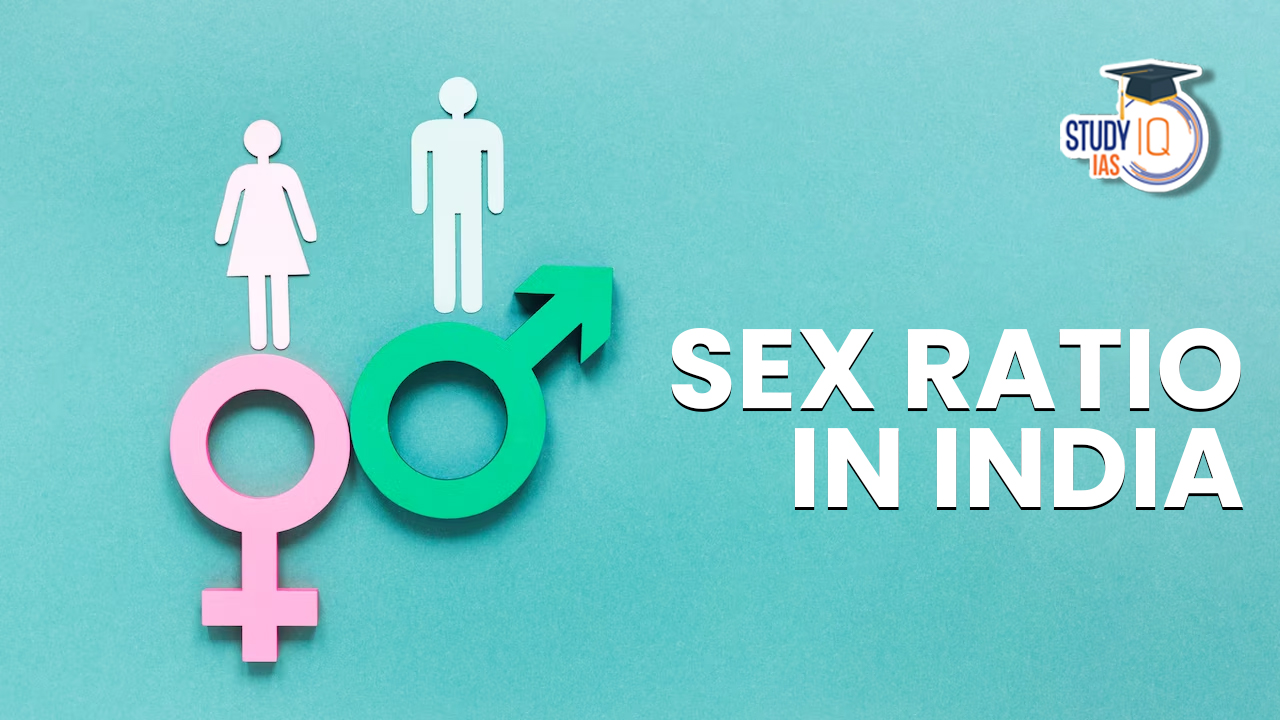Table of Contents
The sex ratio, which measures the number of males per 100 females, is an essential demographic indicator. In India, an imbalanced sex ratio has long been a pressing issue, affecting gender equality and social stability. This article dives into the current statistics, historical trends, and regional disparities in India’s sex ratio as of 2025 and discusses projections for improvement by 2036.
Sex Ratio in Haryana Dropped to an Eight-Year Low in 2024
Haryana’s sex ratio at birth saw a decline in 2024, dropping to 910 girls per 1,000 boys, the lowest since 2016. This drop is concerning, especially after the state made remarkable progress from 871 in 2014 to a peak of 923 in 2019.
Factors Contributing to the Decline
- Loosening Enforcement of Laws: The Pre-Conception and Pre-Natal Diagnostic Techniques Act (PNDT Act), which played a vital role in curbing sex-selective abortions, has seen less stringent enforcement in recent years.
- Cultural and Economic Pressures: Deep-rooted cultural preferences for male children, coupled with economic challenges like rising inflation and the dowry system, continue to influence family decisions.
- Cross-Border Practices: The ease of access to illegal sex determination services in neighboring states has further complicated enforcement efforts.
Current Sex Ratio in India (2025)
As of 2025, India’s population stands at approximately 1.44 billion, including 743.39 million males and 698.29 million females. This gives a sex ratio of about 106 males per 100 females. Men make up 51.56% of the population, while women account for 48.44%—a difference of around 45 million more men than women. Globally, this places India at 214th out of 236 countries for female-to-male ratio, highlighting the need for greater gender balance.
Projected Improvement in Sex Ratio by 2036
According to the “Women and Men in India 2023” report from the Ministry of Statistics and Programme Implementation (MoSPI), India’s population is projected to reach 1.52 billion by 2036. The report forecasts a gradual improvement in the sex ratio from 943 females per 1,000 males in 2011 to 952 females per 1,000 males by 2036. It also anticipates a slight increase in the proportion of females, from 48.5% in 2011 to 48.8% in 2036.
Demographic Changes and Trends
The MoSPI report reveals some notable demographic shifts:
- Declining Youth Population: The proportion of people under age 15 is falling, driven by lower fertility rates. This means that families are generally having fewer children.
- Growing Elderly Population: India’s population of people aged 60 and above is rising, reflecting an aging demographic. This trend indicates that India’s population structure is maturing.
The report also highlights urban-rural and regional differences in gender equality, suggesting that while some areas are making progress, others still face challenges.
Role of Education and Fertility Trends
Changes in fertility patterns are also shaping India’s demographic landscape:
- Delayed Childbirth: The fertility rate among women aged 20-24 and 25-29 has decreased, while rates for women aged 35-39 have slightly increased. This shift suggests that more women are choosing to delay having children, often due to educational and career opportunities.
- Impact of Education on Fertility: Fertility rates among adolescent girls are higher among those with little to no education, underscoring the importance of education in improving health and family planning outcomes for women.
Moving Toward Gender Balance
While India still has a way to go in balancing its sex ratio, positive changes in educational access, urbanization, and family planning are expected to improve the sex ratio and contribute to greater gender equality in the coming years.
Indian Sex Ratio 2025
India’s Sex ratio is 106.453 males per 100 females, or we can say 743,392,561, or 743.39 million males and 698,327,291, or 698.29 million females. In terms of percentage, the male population is 51.56 percent compared to 48.44 percent of the female population. There are a few points as follows:-
- India has the highest number of exceed males population of 45.08 million.
- India is at 214th position out of 236 countries and territories in terms of female-to-male ratio.
- Among Asian countries, its position is 40th out of 51 countries and territories.
- In India, the male-to-female ratio has increased from 105.676 in 1950 to a peak value of 107.432 in 1978.
- This ratio is projected to decline to 101.944 in 2100.
- With about 107.1 boys born for every 100 girls, India has the world’s 17th most skewed sex ratio at birth.
- This ratio has been declining since 2010, when it peaked at 109.6 boys per 100 girls.
- The males-to-females ratio is at the highest point of 110.379 for the age group 20-24.
- With 108.836 boys per 100 girls (0-14 age group), India has the 12th most skewed child-sex ratio.
- The men-to-women ratio is 107.432 for the group aged 15–64 and 90.779 for those over 65.
- India has more males than females aged below 60 years.
- Men are two-thirds of women aged below 90 years.
NFHS-5 Survey for Indian Sex Ratio
According to the National Family Health Survey (NFHS-5) for 2020-21, India’s Sex Ratio in 2023 was 1020 females per 1000 males.
- In rural areas, the sex ratio is 1037, and in urban areas, it’s 985 females to 1000 males. The sex ratio at birth also continues to be lower than what is expected.
- In 2022-23, the sex ratio at birth improved by 15 points to 933.
- The sex ratio at birth for children born in the last five years in India is 929 females per 1,000 males.
- However, in 2015-17, the sex ratio in India at birth (SRB) came down to an all-time low of 896. Kerala has the highest sex ratio in India, with 1084 females for every 1000 males.
- The overall gender ratio of Indian states is poor compared to developed countries.
| Sex Ratio (Females per 1000 Males) | 2011 Census | 2023 (NFHS-5 Survey) |
| Rural | 949 | 1037 |
| Urban | 929 | 985 |
| India | 943 | 1020 |
Male-Female Ratio in India 2025
- India’s sex ratio in 2023 is 1,020 females per 1,000 males.
- The sex ratio in rural areas is 985 females to 1,000 males, and in urban areas, it’s 985 females to 1,000 males. The sex ratio at birth has improved by 15 points from 918 in 2014-15 to 933 in 2022-23.
- The sex ratio at birth went up by three points to 907 in 2018-20 from 904 in 2017-19.
- The current population of India is 1,441,459,746, with a current male population of 51.6% and a current female population of 48.4%.
Types of Sex Ratio
There are 4 types of sex ratios divided according to the stages of development.
- Primary Sex Ratio (PSR): This ratio represents the number of males to females at conception, including data from abortions, miscarriages, and stillbirths.
- Secondary Sex Ratio (SSR): Known as the ‘Natural Sex Ratio,’ this ratio is measured at birth and universally shows more males than females.
- Tertiary Sex Ratio (TSR): This ratio pertains to mature adolescents in their 20s, where typically, the number of males exceeds females.
- Quaternary Sex Ratio (QSR): Also called the Adult Sex Ratio, this ratio measures the number of adults aged 60 and above.
Sex Ratio in India
According to the 2011 census, the male and female populations in India are 623.7 million and 586.4 million, respectively, out of a total population of 1210.1 million. Sex Ratio in India stands at 943, indicating that for every 1,000 males, there are 943 females.
A skewed sex ratio favouring males is a concerning signal, often associated with a higher risk of female fetal mortality. This issue is particularly prevalent in regions where parents selectively choose the gender of their children, leading to the tragic practice of female foeticide. The declining sex ratios present a significant threat to India’s future female population.
Child Sex Ratio (CSR)
The Child Sex Ratio (CSR), representing the number of females per 1,000 males in the 0–6-year-old category, is a critical demographic indicator. India’s CSR was 927 in the 2001 census but saw a decline to 918 in the 2011 census. The sex ratio is calculated using the formula:
Sex Ratio = (Number of Females / Number of Males) x 1000
Historical Perspective of Sex Ratio in India Trends
The sex ratio in India, a critical demographic indicator, has consistently declined since 1901, as per Census data. The world sex ratio standard measures the Sex Ratio at Birth (SRB) as the number of boys born per 100 girls. India uses a different metric, recording female births per 1,000 male births. This alarming trend isn’t restricted to specific age groups; it reflects a broader imbalance, with the general sex ratio falling from 972 in 1901 to 940 in 2011.
India’s historical bias against females is evident in this data. The post-independence era saw a decline in the sex ratio for two decades, reaching a low of 930 in 1971, with some fluctuations after that. The latest provisional results suggest a slight improvement, but the issue of an unfavorable sex ratio persists as a significant concern, demanding continued attention and measures to promote gender equality.
| Category | 1951 | 1991 | 2001 | 2011 |
|---|---|---|---|---|
| Sex Ratio (Rural) | 965 | – | – | 946 |
| Sex Ratio (Urban) | 860 | – | – | 929 |
| Sex Ratio (India) | 946 | – | – | 943 |
| Child Sex Ratio (India) | – | 945 | 927 | – |
Additional Information
- The natural sex ratio at birth is around 105 boys per 100 girls (often expressed as 950 girls per 1,000 boys in India).
- Despite increasing per capita income, the sex ratio has declined, potentially due to the affordability of sex-selective procedures.
- The Pre-conception and Pre-Natal Diagnostic Techniques (Prohibition of Sex Selection) Act was passed in 1994 to combat sex selection and regulate prenatal diagnostic techniques.
Check out the linked article on the UPSC Syllabus 2024
Sex ratio of India From 1901 to 2021
| S.N. | Census Year | Sex Ratio (females/1000 males) |
| 1. | 1901 | 972 |
| 2. | 1911 | 964 |
| 3. | 1921 | 955 |
| 4. | 1931 | 950 |
| 5. | 1941 | 945 |
| 6. | 1951 | 946 |
| 7. | 1961 | 941 |
| 8. | 1971 | 930 |
| 9. | 1981 | 934 |
| 10. | 1991 | 927 |
| 11. | 2001 | 933 |
| 12. | 2011 | 943 |
| 13. | 2021 | 1,020 |
Check out the linked article on the UPSC Mains Syllabus 2024 Here!
Sex Ratio of States and UTs Data
| State/UT Rank | Name of state or Union Territory | Sex Ratio of India 2021 |
| 1. | Kerala | 1084 |
| 2. | Puducherry | 1038 |
| 3. | Tamil Nadu | 995 |
| 4. | Andhra Pradesh | 992 |
| 5. | Chhattisgarh | 991 |
| 6. | Manipur | 987 |
| 7. | Meghalaya | 986 |
| 8. | Odisha | 978 |
| 9. | Mizoram | 975 |
| 10. | Himachal Pradesh | 974 |
| 11. | Karnataka | 968 |
| 12. | Goa | 968 |
| 13. | Uttarakhand | 963 |
| 14. | Tripura | 961 |
| 15. | Assam | 954 |
| 16. | Jharkhand | 947 |
| 17. | West Bengal | 947 |
| 18. | Lakshadweep | 946 |
| 19. | Nagaland | 931 |
| 20. | Madhya Pradesh | 930 |
| 21. | Rajasthan | 926 |
| 22. | Maharashtra | 925 |
| 23. | Arunachal Pradesh | 920 |
| 24. | Gujarat | 918 |
| 25. | Bihar | 916 |
| 26. | Uttar Pradesh | 908 |
| 27. | Punjab | 893 |
| 28. | Sikkim | 889 |
| 29. | Jammu& Kashmir | 883 |
| 30. | Andaman & Nicobar islands | 878 |
| 31. | Haryana | 877 |
| 32. | NCT of Delhi | 866 |
| 33. | Chandigarh | 818 |
| 34. | Dadra and Nagar Haveli | 775 |
| 35. | Daman and Diu | 618 |
| Overall | India | 943 |
State-wise Sex Ratio in India 2025
Highest sex ratio in India
- Kerala (1084)
- Tamil Nadu (995)
- Andhra Pradesh (992)
| Kerala Sex Ratio 2024 |
| As of July 2024, the sex ratio in Kerala, India is 1,084 females per 1,000 males, which is higher than the national average of 940. |
Lowest sex ratio in India
- Haryana (877)
- Jammu and Kashmir (883)
- Sikkim (889)
Child Sex Ratio (0-6 years) – Top Performers
- Mizoram (971)
- Meghalaya (970)
- Chhattisgarh (964)
Child Sex Ratio (0-6 years) – Lowest Performers
- Haryana (830)
- Punjab (846)
- Jammu and Kashmir (859)
Union Territories (UTs) – Top Overall Sex Ratio
- Puducherry (1038)
- Lakshadweep (946)
- Andaman and Nicobar Islands (878)
Union Territories (UTs) – Lowest Overall Sex Ratio
- Daman and Diu (618)
- Dadra and Nagar Haveli (775)
- Chandigarh (818)
States and UTs with Declining Overall Sex Ratios
- Bihar
- Jammu and Kashmir
- Dadra and Nagar Haveli
- Daman and Diu
- Lakshadweep
Improving Child Sex Ratios (0-6 years) in Census 2011
- Punjab (798 to 846, +57 points)
- Haryana (819 to 830, +11 points)
- Himachal Pradesh (896 to 906, +10 points)
- Chandigarh (845 to 867, +22 points)
- Gujarat (883 to 886, +3 points)
- Tamil Nadu (942 to 946, +4 points)
- Mizoram (964 to 971, +7 points)
- Andaman & Nicobar Islands (957 to 966, +9 points)
Telangana Demographics (formed in 2014)
- Total Population: 351.94 lakhs
- Male Population: 177.04 lakhs
- Female Population: 174.90 lakhs
- Sex Ratio (Female per 1000 Males): 988
- Child Sex Ratio: 933
Karnataka Sex Ratio 2025
- Bangalore has the highest population and lowest sex ratio, indicating an urban-rural disparity
- Udupi has the highest sex ratio, reflecting better gender balance.
- Kodagu has the highest child-sex ratio, whereas Belgaum shows the lowest.
- The average sex ratio in Karnataka is 973, and the average child sex ratio is 948, with districts like Udupi, Dakshina Kannada, and Kodagu showing favorable female-to-male ratios.
| Key Insight |
District(s) / Value
|
| Highest Population |
Bangalore: 9,621,551
|
| Lowest Population |
Bangalore Rural: 990,923
|
| Highest Sex Ratio | Udupi: 1,094 |
| Lowest Sex Ratio | Bangalore: 916 |
| Highest Child Sex Ratio | Kodagu: 978 |
| Lowest Child Sex Ratio | Belgaum: 934 |
| Average Sex Ratio for Karnataka | 973 |
| Average Child Sex Ratio for Karnataka | 948 |
| Districts with Sex Ratio > 1,000 |
Udupi (1,094), Dakshina Kannada (1,020), Kodagu (1,019), Hassan (1,010), Raichur (1,000)
|
| District with Exact Balance | Raichur: 1,000 |
| Districts with Lowest Gender Balance |
Bangalore (916), Bidar (956), Bijapur (960)
|
| Lower Child Sex Ratio Compared to Overall Sex Ratio |
Mandya, Belgaum, Dharwad
|
| Urban vs. Rural Trend |
Bangalore (Urban, Low Sex Ratio: 916) vs. Udupi (Rural, High Sex Ratio: 1,094)
|
| Higher Sex Ratio in Smaller Population Districts |
Udupi (1,094), Kodagu (1,019)
|
| Large Population Districts with Low Child Sex Ratio |
Belgaum, Bijapur
|
| Outliers |
Udupi: High Overall & Child Sex Ratios
|
Sex Ratio at Birth
While the overall sex ratio is positive, it’s important to note that the sex ratio at birth (SRB) is still skewed towards boys compared to the natural SRB, which is 952 girls per 1,000 boys. States like Uttar Pradesh, Haryana, Punjab, Rajasthan, Bihar, Delhi, Jharkhand, Andhra Pradesh, Tamil Nadu, Odisha, and Maharashtra exhibit lower SRB.
Women and Men in India 2022 Report
Ministry of Statistics and Programme Implementation has released the Women and Men in India 2022 report.
Improvement in Sex Ratio
- India’s expected sex ratio is projected to improve significantly from 943 in 2011 to 952 by 2036, per the Women and Men in India 2022 report.
- The sex ratio at birth increased by three points from 904 in 2017-19 to 907 in 2018-20, according to the Union Ministry of Statistics and Programme Implementation.
Gender Disparities in the Labour Force
- Women’s participation in the labour force remains low in India, hindering their financial independence.
- India’s Labor Force Participation Rate (LFPR) for those above 15 years of age has risen since 2017-2018, but women significantly lag behind men.
- In 2021-22, the LFPR was 77.2% for males but only 32.8% for females, with no improvement in this disparity.
- The low participation of women in the labor force is attributed to social factors, educational qualifications, and gender discrimination in wages and opportunities.
- Wage disparities persist, with men in rural areas earning more than women in urban areas for similar work.
Population Trends
- India’s population growth has been on a downward trend, decreasing from 2.2% in 1971 to 1.1% in 2021, and is projected to fall further to 0.58% by 2036.
- The female population share is expected to marginally improve from 48.5% in Census 2011 to 48.8% in 2036.
- Population projections indicate a decline in the population under 15 years of age and an increase in the population above 60 years by 2036. This shift will reshape the population pyramid.
- The age and sex structure of the population significantly impact gender-related issues, influenced by trends in fertility and mortality.
- Gender disparities in access to healthcare persist, with women facing challenges due to limited access to resources, decision-making power, and mobility.
Age-Specific Fertility Rate
- The age-specific fertility rate, reflecting live births in specific age groups of women per thousand females in that age group, has shown changes.
- For the age groups of 20-24 years and 25-29 years, the fertility rate decreased from 135.4 and 166.0 to 113.6 and 139.6, respectively, between 2016 and 2020. This decrease is associated with economic independence through education and employment.
- However, the same indicator for the 35-39 age group increased from 32.7 in 2016 to 35.6 in 2020.
- The mean age for marriage has marginally improved from 22.1 years in 2017 to 22.7 years in 2020.
- Other positive trends include a decline in infant and under-five mortality rates, as indicated by data from the National Family Health Survey.
Check out the linked article on the UPSC Study Material 2024
Reasons for Declining Sex Ratio in India
The declining sex ratio of India can be attributed to several factors, including:
- Son Preference: Cultural preference for male children leads to sex-selective practices.
- Gender Disparity at Birth: More male births compared to female births.
- Female Infanticide: Despite being illegal, it still occurs in some regions.
- Sex Determination Testing: Preference for males leads to sex determination tests and potential pregnancy termination.
- Ineffective Laws: Challenges in implementing laws against sex selection.
- Small Family Norms: Some couples opt for smaller families if they have a male child.
- Dowry Practices: Economic pressures due to dowry can lead to neglect of female children.
- Surplus of Males: Imbalance can lead to difficulties in finding suitable partners for men, resulting in social issues.
Check out the linked article on the UPSC Prelims Syllabus 2024 Here!
National Family Health Survey-5 Findings
Key findings from the NFHS-5 survey reveal significant demographic trends in India:
Sex Ratio Improvement
The data from 2019-2021 indicates a notable improvement in the sex ratio, with 1,020 women for every 1,000 men, marking the highest sex ratio recorded in NFHS surveys since the first modern synchronous census in 1881.
Steps Taken to Improve Sex Ratio
Several steps have been taken in India to improve the sex ratio, including:
- Legal Ban on Sex Determination: The PCPNDT (Pre-Conception and Pre-Natal Diagnostic Techniques) Act strictly prohibits sex determination during pregnancy, aiming to prevent selective abortions based on gender.
- National Girl Child Day: In 2012, January 24th was declared National Girl Child Day, emphasizing the importance of the girl child and promoting gender equality.
- Sabla Scheme: Launched on International Women’s Day in 2011, the Sabla scheme focuses on empowering adolescent girls by promoting self-development, improving their health and nutrition, and raising awareness about various aspects of health, hygiene, nutrition, and reproductive health.
- Beti Bachao Beti Padhao (BBBP) Scheme: Initiated in 2015 in Panipat, Haryana, this scheme has three main objectives:
- Prevention of gender-biased sex-selective elimination.
- Ensuring the survival and protection of the girl child.
- Promoting education and active participation of the girl child.
These measures represent a concerted effort by the Indian government and various stakeholders to combat gender discrimination and improve the sex ratio, with a particular focus on empowering and safeguarding the rights of girls and women.
Check the Beti Bachao Beti Padhao (BBBP) Scheme in detail here.
Difference Between Sex Ratio and Gender Ratio
| Sex Ratio | Gender Ratio |
| Biological sex | Social gender |
| Sex ratio is the ratio of females to males per 1000 individuals in a population. | The proportion of males to females in a society is known as the gender ratio. |
| Sex ratio =Number of females/Number of males | The gender ratio is not stable but instead shaped by biological, social, technological, cultural, and economic forces. |
Sex Ratio in India UPSC
- The sex ratio of India has steadily declined since 1901, with the 2011 census reporting 943 females per 1,000 males.
- Root causes include cultural son preference, gender disparities at birth, and sex-selective practices like female infanticide.
- Measures to address this issue include banning sex determination during pregnancy, promoting National Girl Child Day, and schemes like Sabla and Beti Bachao Beti Padhao.
- Despite efforts, gender disparities persist in labour force participation and healthcare access.
- India’s future demographics indicate declining population growth and an evolving age structure, underscoring the ongoing need to combat gender imbalances and promote equality.


 Desert Climate, Distribution, Climatic C...
Desert Climate, Distribution, Climatic C...
 Deserts of India Map, Features of Thar D...
Deserts of India Map, Features of Thar D...
 Indus Valley Civilization, History, Phas...
Indus Valley Civilization, History, Phas...





















